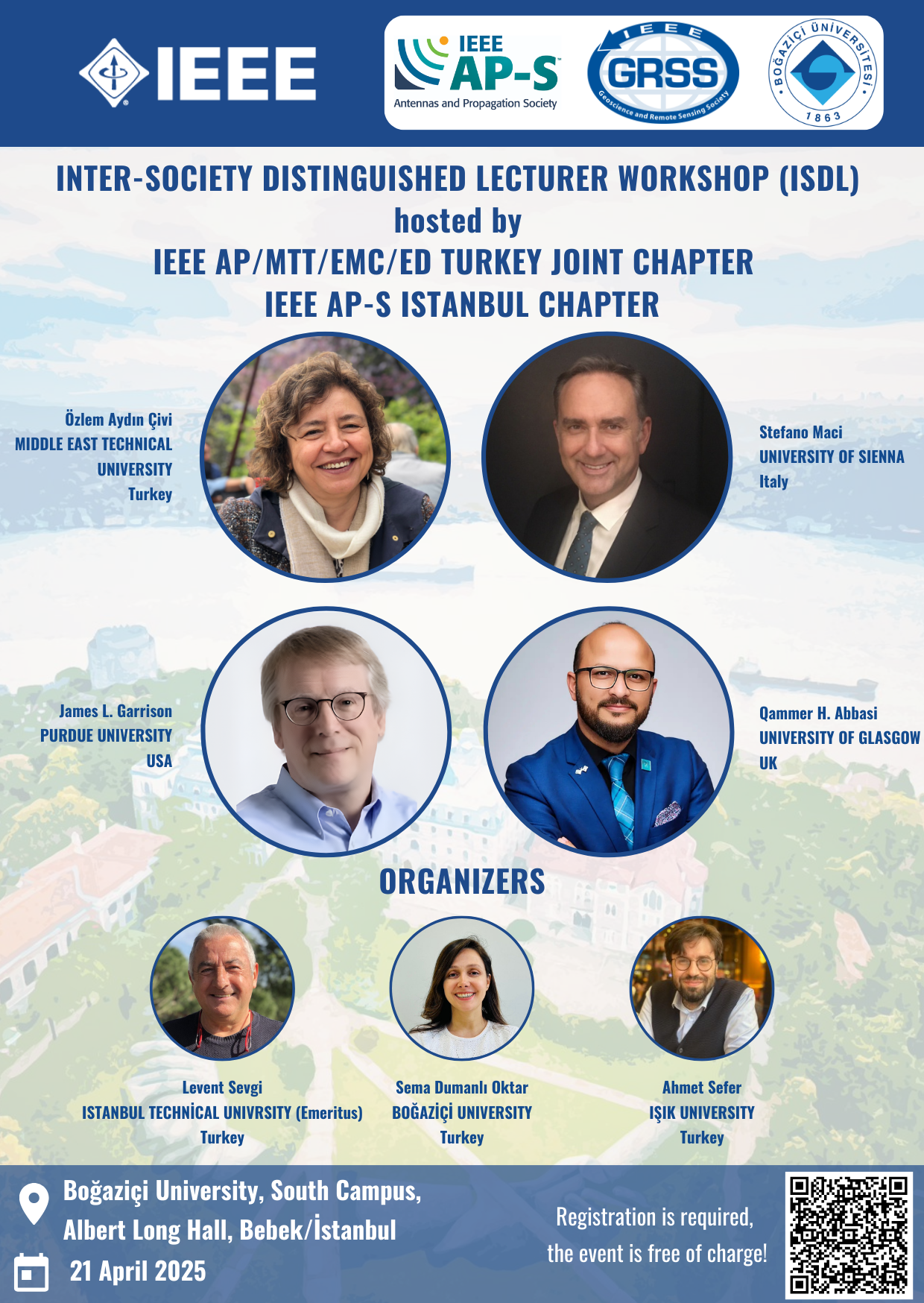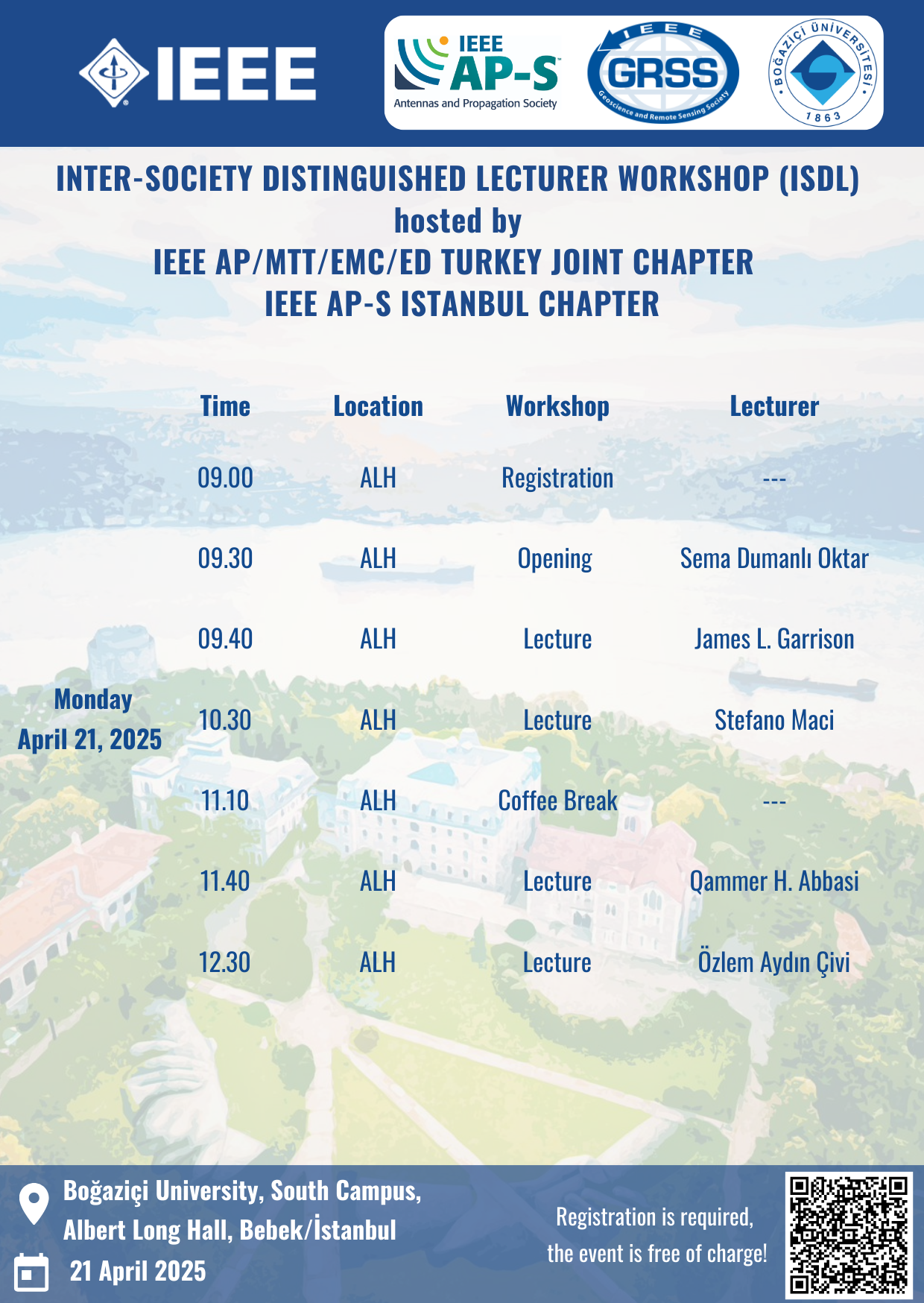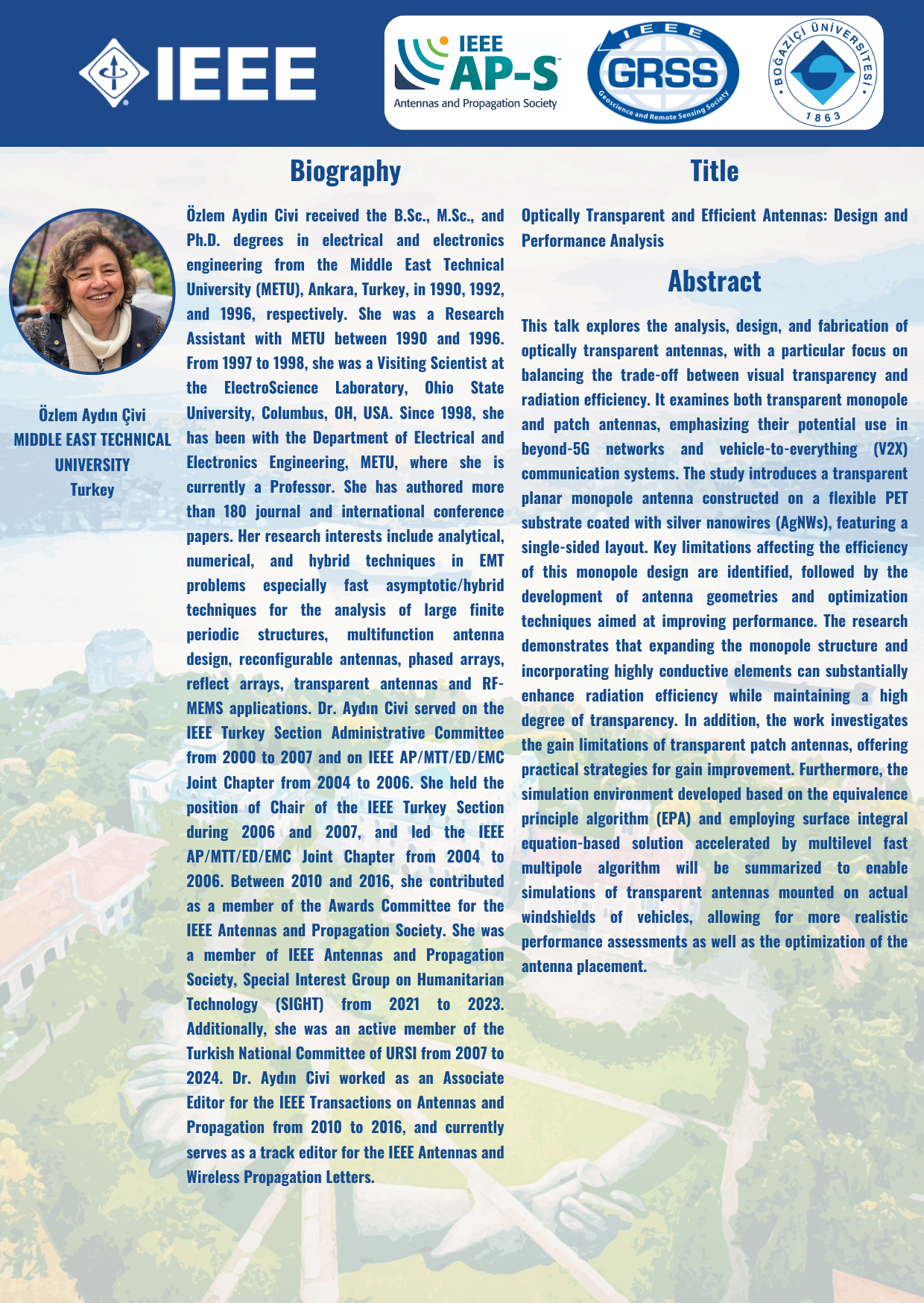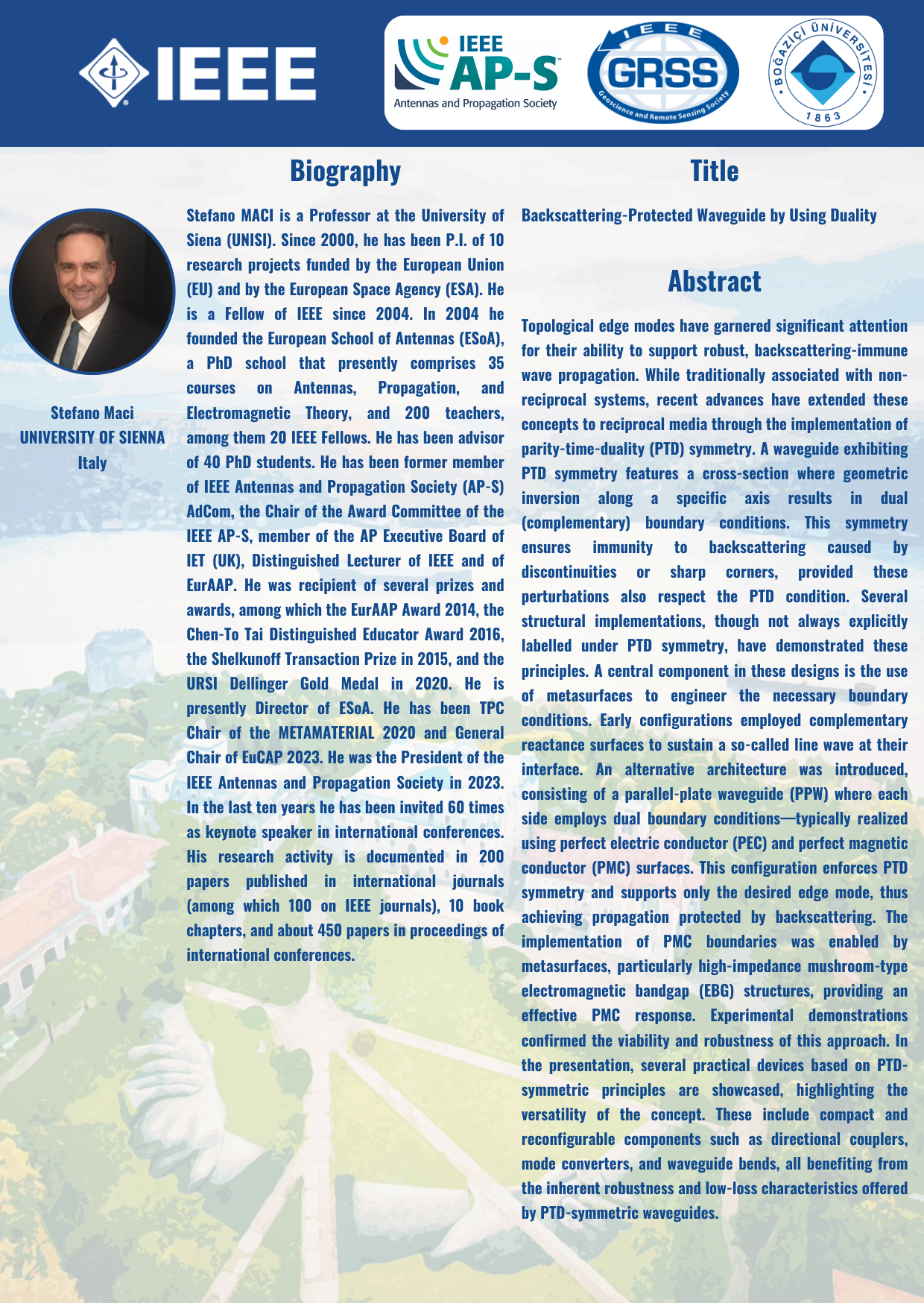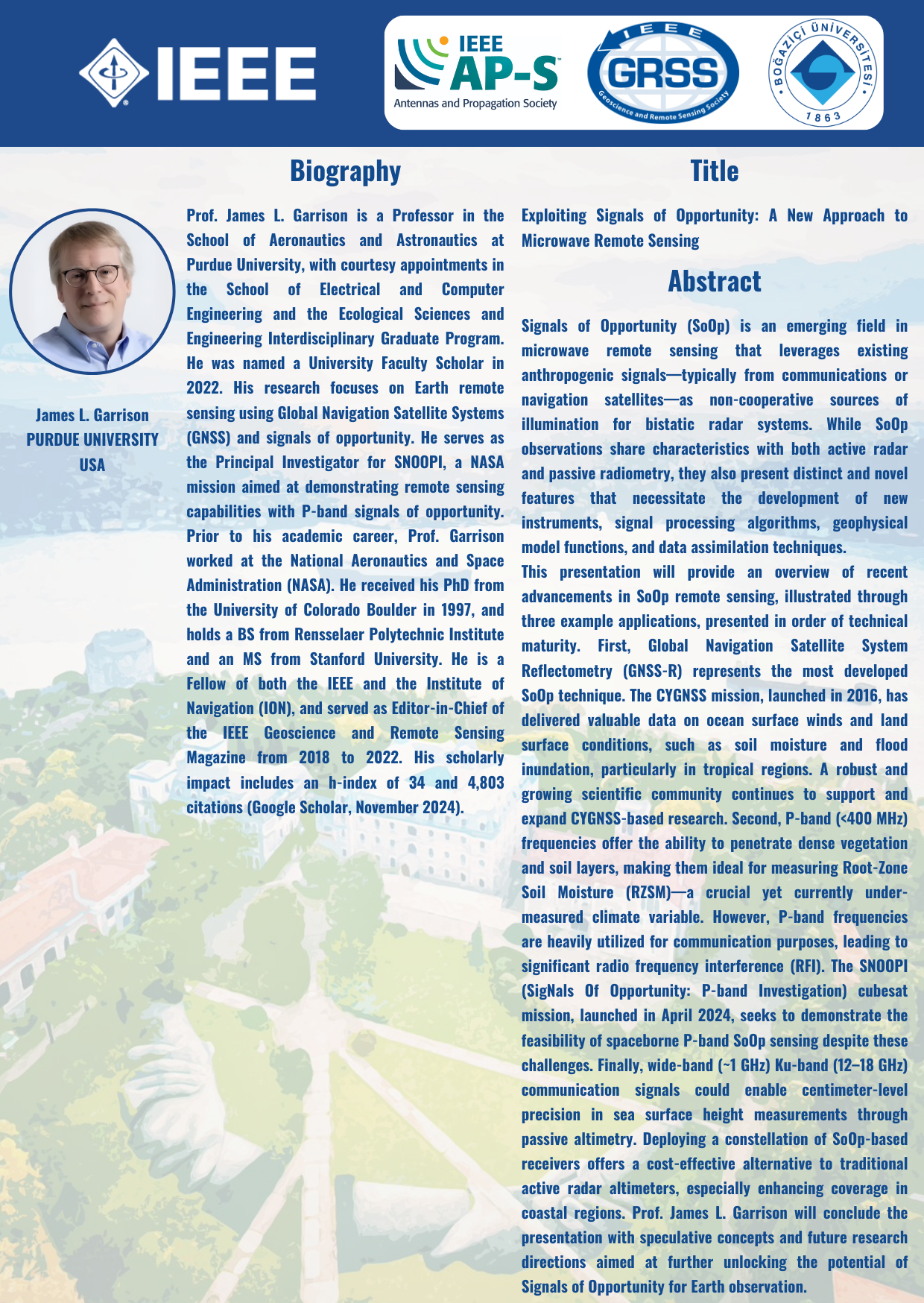INTER-SOCIETY DISTINGUISHED LECTURER WORKSHOP (ISDL) hosted by IEEE AP/MTT/EMC/ED TURKEY JOINT CHAPTER IEEE AP-S Istanbul Chapter
We are delighted to invite you to the Inter-Society Distinguished Lecturer (ISDL) Workshop hosted by the IEEE AP/MTT/EMC/ED Turkey Joint Chapter and the IEEE AP-S Istanbul Chapter.
🗓 Date: April 21, 2025
📍 Location: Boğaziçi University, South Campus – Albert Long Hall, Bebek, Istanbul
🎟 Registration: Required – Free of charge! https://forms.gle/7JAwZu2aTyd76CdP6
This one-day event brings together an exceptional group of speakers from around the world:
This is an in-person event.
Date and Time
Location
Hosts
Registration
-
 Add Event to Calendar
Add Event to Calendar
Speakers
Prof. Özlem Aydın Çivi of METU
Optically Transparent and Efficient Antennas: Design and Performance Analysis
This talk explores the analysis, design, and fabrication of optically transparent antennas, with a particular focus on balancing the trade-off between visual transparency and radiation efficiency. It examines both transparent monopole and patch antennas, emphasizing their potential use in beyond-5G networks and vehicle-to-everything (V2X) communication systems. The study introduces a transparent planar monopole antenna constructed on a flexible PET substrate coated with silver nanowires (AgNWs), featuring a single-sided layout. Key limitations affecting the efficiency of this monopole design are identified, followed by the development of antenna geometries and optimization techniques aimed at improving performance. The research demonstrates that expanding the monopole structure and incorporating highly conductive elements can substantially enhance radiation efficiency while maintaining a high degree of transparency. In addition, the work investigates the gain limitations of transparent patch antennas, offering practical strategies for gain improvement. Furthermore, the simulation environment developed based on the equivalence principle algorithm (EPA) and employing surface integral equation-based solution accelerated by multilevel fast multipole algorithm will be summarized to enable simulations of transparent antennas mounted on actual windshields of vehicles, allowing for more realistic performance assessments as well as the optimization of the antenna placement.
Biography:
Özlem Aydin Civi received the B.Sc., M.Sc., and Ph.D. degrees in electrical and electronics engineering from the Middle East Technical University (METU), Ankara, Turkey, in 1990, 1992, and 1996, respectively. She was a Research Assistant with METU between 1990 and 1996. From 1997 to 1998, she was a Visiting Scientist at the ElectroScience Laboratory, Ohio State University, Columbus, OH, USA. Since 1998, she has been with the Department of Electrical and Electronics Engineering, METU, where she is currently a Professor. She has authored more than 180 journal and international conference papers. Her research interests include analytical, numerical, and hybrid techniques in EMT problems especially fast asymptotic/hybrid techniques for the analysis of large finite periodic structures, multifunction antenna design, reconfigurable antennas, phased arrays, reflect arrays, transparent antennas and RF-MEMS applications. Dr. Aydın Civi served on the IEEE Turkey Section Administrative Committee from 2000 to 2007 and on IEEE AP/MTT/ED/EMC Joint Chapter from 2004 to 2006. She held the position of Chair of the IEEE Turkey Section during 2006 and 2007, and led the IEEE AP/MTT/ED/EMC Joint Chapter from 2004 to 2006. Between 2010 and 2016, she contributed as a member of the Awards Committee for the IEEE Antennas and Propagation Society. She was a member of IEEE Antennas and Propagation Society, Special Interest Group on Humanitarian Technology (SIGHT)
from 2021 to 2023. Additionally, she was an active member of the Turkish National Committee of URSI from 2007 to 2024. Dr. Aydın Civi worked as an Associate Editor for the IEEE Transactions on Antennas and Propagation from 2010 to 2016, and currently serves as a track editor for the IEEE Antennas and Wireless Propagation Letters.
Prof. Dr. Stefano Maci of University of Siena
Backscattering-Protected Waveguide by Using Duality
Topological edge modes have garnered significant attention for their ability to support robust, backscattering-immune wave propagation. While traditionally associated with non-reciprocal systems, recent advances have extended these concepts to reciprocal media through the implementation of parity-time-duality (PTD) symmetry. A waveguide exhibiting PTD symmetry features a cross-section where geometric inversion along a specific axis results in dual (complementary) boundary conditions. This symmetry ensures immunity to backscattering caused by discontinuities or sharp corners, provided these perturbations also respect the PTD condition. Several structural implementations, though not always explicitly labelled under PTD symmetry, have demonstrated these principles. A central component in these designs is the use of metasurfaces to engineer the necessary boundary conditions. Early configurations employed complementary reactance surfaces to sustain a so-called line wave at their interface. An alternative architecture was introduced, consisting of a parallel-plate waveguide (PPW) where each side employs dual boundary conditions—typically realized using perfect electric conductor (PEC) and perfect magnetic conductor (PMC) surfaces. This configuration enforces PTD symmetry and supports only the desired edge mode, thus achieving propagation protected by backscattering. The implementation of PMC boundaries was enabled by metasurfaces, particularly high-impedance mushroom-type electromagnetic bandgap (EBG) structures, providing an effective PMC response. Experimental demonstrations confirmed the viability and robustness of this approach. In the presentation, several practical devices based on PTD-symmetric principles are showcased, highlighting the versatility of the concept. These include compact and reconfigurable components such as directional couplers, mode converters, and waveguide bends, all benefiting from the inherent robustness and low-loss characteristics offered by PTD-symmetric waveguides.
Biography:
Stefano MACI is a Professor at the University of Siena (UNISI). Since 2000, he has been P.I. of 10 research projects funded by the European Union (EU) and by the European Space Agency (ESA). He is a Fellow of IEEE since 2004. In 2004 he founded the European School of Antennas (ESoA), a PhD school that presently comprises 35 courses on Antennas, Propagation, and Electromagnetic Theory, and 200 teachers, among them 20 IEEE Fellows. He has been advisor of 40 PhD students. He has been former member of IEEE Antennas and Propagation Society (AP-S) AdCom, the Chair of the Award Committee of the IEEE AP-S, member of the AP Executive Board of IET (UK), Distinguished Lecturer of IEEE and of EurAAP. He was recipient of several prizes and awards, among which the EurAAP Award 2014, the Chen-To Tai Distinguished Educator Award 2016, the Shelkunoff Transaction Prize in 2015, and the URSI Dellinger Gold Medal in 2020. He is presently Director of ESoA. He has been TPC Chair of the METAMATERIAL 2020 and General Chair of EuCAP 2023. He was the President of the IEEE Antennas and Propagation Society in 2023. In the last ten years he has been invited 60 times as keynote speaker in international conferences. His research activity is documented in 200 papers published in international journals (among which 100 on IEEE journals), 10 book chapters, and about 450 papers in proceedings of international conferences.
Prof. James L. Garrison of Purdue University
Exploiting Signals of Opportunity: A New Approach to Microwave Remote Sensing
Signals of Opportunity (SoOp) is an emerging field in microwave remote sensing that leverages existing anthropogenic signals—typically from communications or navigation satellites—as non-cooperative sources of illumination for bistatic radar systems. While SoOp observations share characteristics with both active radar and passive radiometry, they also present distinct and novel features that necessitate the development of new instruments, signal processing algorithms, geophysical model functions, and data assimilation techniques.
This presentation will provide an overview of recent advancements in SoOp remote sensing, illustrated through three example applications, presented in order of technical maturity. First, Global Navigation Satellite System Reflectometry (GNSS-R) represents the most developed SoOp technique. The CYGNSS mission, launched in 2016, has delivered valuable data on ocean surface winds and land surface conditions, such as soil moisture and flood inundation, particularly in tropical regions. A robust and growing scientific community continues to support and expand CYGNSS-based research. Second, P-band (<400 MHz) frequencies offer the ability to penetrate dense vegetation and soil layers, making them ideal for measuring Root-Zone Soil Moisture (RZSM)—a crucial yet currently under-measured climate variable. However, P-band frequencies are heavily utilized for communication purposes, leading to significant radio frequency interference (RFI). The SNOOPI (SigNals Of Opportunity: P-band Investigation) cubesat mission, launched in April 2024, seeks to demonstrate the feasibility of spaceborne P-band SoOp sensing despite these challenges. Finally, wide-band (~1 GHz) Ku-band (12–18 GHz) communication signals could enable centimeter-level precision in sea surface height measurements through passive altimetry. Deploying a constellation of SoOp-based receivers offers a cost-effective alternative to traditional active radar altimeters, especially enhancing coverage in coastal regions. Prof. James L. Garrison will conclude the presentation with speculative concepts and future research directions aimed at further unlocking the potential of Signals of Opportunity for Earth observation.
Biography:
Prof. James L. Garrison is a Professor in the School of Aeronautics and Astronautics at Purdue University, with courtesy appointments in the School of Electrical and Computer Engineering and the Ecological Sciences and Engineering Interdisciplinary Graduate Program. He was named a University Faculty Scholar in 2022. His research focuses on Earth remote sensing using Global Navigation Satellite Systems (GNSS) and signals of opportunity. He serves as the Principal Investigator for SNOOPI, a NASA mission aimed at demonstrating remote sensing capabilities with P-band signals of opportunity. Prior to his academic career, Prof. Garrison worked at the National Aeronautics and Space Administration (NASA). He received his PhD from the University of Colorado Boulder in 1997, and holds a BS from Rensselaer Polytechnic Institute and an MS from Stanford University. He is a Fellow of both the IEEE and the Institute of Navigation (ION), and served as Editor-in-Chief of the IEEE Geoscience and Remote Sensing Magazine from 2018 to 2022. His scholarly impact includes an h-index of 34 and 4,803 citations (Google Scholar, November 2024).
Prof. Qammer H. Abbasi of University of Glasgow
Recon gurable Intelligent Surfaces (RIS) for Communication, Sensing, and Localisation
Reconfigurable Intelligent Surfaces (RIS) have emerged as a transformative technology for next-generation wireless networks, enabling precise control of electromagnetic waves to enhance communication, sensing, and localisation. RIS leverages programmable metasurfaces composed of sub-wavelength reflective elements to dynamically manipulate the amplitude, phase, and polarization of incident waves. This capability supports diverse applications in 6G scenarios, including high-speed data transmission, real-time health monitoring, and indoor localisation. In communication, RIS improves energy efficiency and signal coverage, particularly in Non-Line-of-Sight (NLoS) environments. It achieves efficient beamforming with minimal power consumption and low hardware complexity. For sensing applications, RIS enables high-accuracy vital sign detection, including real-time heartbeat and respiration monitoring in NLoS conditions, overcoming limitations of conventional RF sensing technologies. For localisation, RIS enhances the performance of machine-learning-based indoor positioning systems by reshaping radio wave propagation and reducing multipath fading effects. The technology supports both active and passive localisation methods, making it ideal for complex, dynamic environments. RIS holds immense potential in integrated sensing and communication (ISAC) systems, paving the way for innovative solutions in smart homes, healthcare, and urban environments. By addressing challenges such as NLoS coverage, hardware constraints, and energy efficiency, RIS is poised to play a critical role in realising the vision of ubiquitous, intelligent, and sustainable wireless networks.
Biography:
Qammer H. Abbasi (SMIEEE, FRET, FRSA, FEAI, FIET), Professor of Applied Electromagnetics & Sensing with the James Watt School (JWS) of Engineering, Theme lead for Connecting People priority at JWS, Director for Communication Sensing and Imaging (CSI) Hub and UK Government’s Policy Advisor in Department for Science Innovation & Technology. He has grant portfolio of £13M+ and contributed to more than 500+ leading international technical journal (including nature portfolio) and peer reviewed conference papers, 11 books and received several recognitions for his research including UK exceptional talent endorsement by Royal Academy of Engineering, Sensor 2021 Young Scientist Award, University level Teaching excellence award in addition to coverage by various media houses globally, BBC news, Scotland TV, Fiercewireless, theEngineers and many other media houses. Prof. Abbasi is an IEEE senior member and is chair of IEEE APS/MTT UK, Ireland and Scotland joint chapter. He is an Associate editor for IEEE Sensors, IEEE open journal of Antenna and Propagation, IEEE JBHI and scientific reports. He is IEEE APS distinguished lecturer (2024-26), Vice-Chair of IEEE APS Young professional committee, Sub-committee chair for IEEE YP Ambassador program, committee member for IEEE 1906.1.1 standard on nano communication, IEEE APS/SC WG P145, IET Antenna & Propagation and healthcare network. He is/was Fellow of Royal Society of Arts, industrial Fellow of Royal Academy of Engineering (2022-23), Fellow of Institution of Engineering & Technology and Fellow of European Alliance of innovation.


